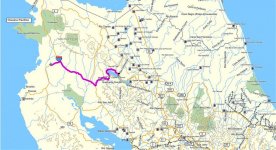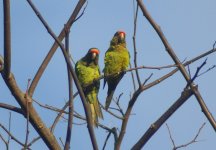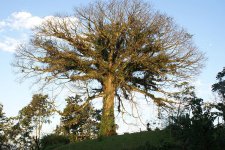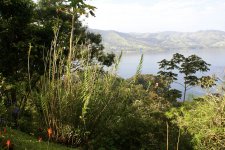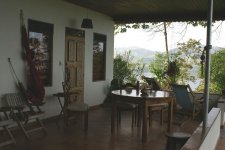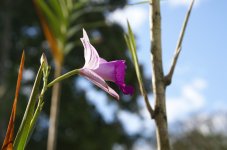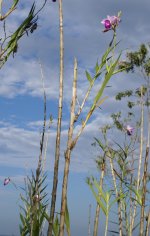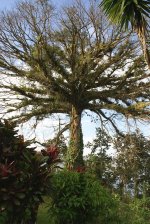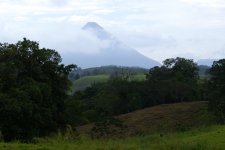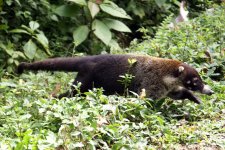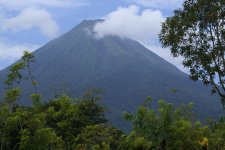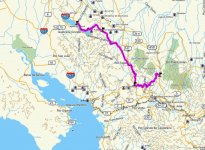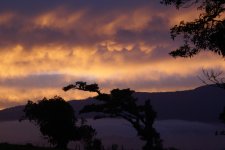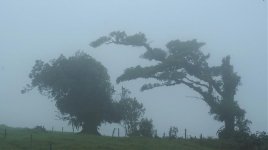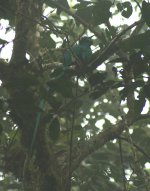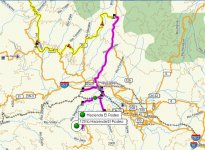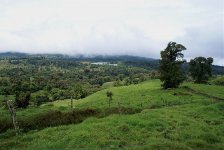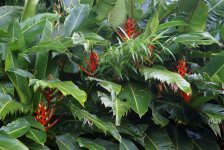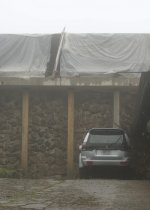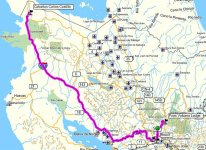Peter C.
...just zis guy, you know?
Introduction:
[Warning! Today’s post contains lots of really boring stuff! Travel details and such, for those who are interested in such things. To see the part that actually is about birds, skip down a couple of posts, to the one headed “Day 1”]
In mid-February, 2010, the "spousal equivalent" and I just managed to set aside a week for vacation, and we decided to use it to make another trip (our fourth) to Costa Rica.
In the time leading up to this trip, some people (workmates, family members) expressed surprise at this choice of destination – “Costa Rica, again?!” would be the phase that would best sum up their collective reaction. None of these people, as you may well have already surmised, are of the birding persuasion. When I tried to bring a factual point to bear, pointing out that this small country has a greater variety of birds (and, for that matter, orchids, butterflies, trees…) than exist in all of the U. S. and Canada combined, I was usually met with stares of frank disbelief. Long explanations of the mysteries of biogeography were just not on, so I would just give up at this point.
“Bird people” of course, know better. But, even among this enlightened group, I can well imagine that a question of this nature might still arise, albeit in a more thoughtful form; “Why are you returning to this same country again, when there are so many other destinations that you’re never visited at all?” Well, there are many possible answers to this question – and I will not bore everyone with a lengthy exposition on the subject of “Costa Rica versus other birding destinations” within the context of this forum. However, putting it in most distilled form I can manage, I will say this much: from the climate, to the people, to the gallo pinto and papaya breakfasts, this is the place where it all comes together for me. Oh, yes, and there are some good birds too...
In a more immediate, practical sense, we had three motives for going to Costa Rica on this particular trip:
Some Practical Info.
The Flight:
We flew with Skyservice, a fairly low-priced charter carrier with two flights a week between Toronto (YYZ) and Liberia, Costa Rica (LIR). Most of the passengers on these flights are headed for resorts – there being many fine beaches within one or two hours’ drive of LIR – but air-only flights are usually easily obtained (but book early – the tour companies buy in bulk!). As I alluded to before, the flight is direct and non-stop – a huge advantage, compared to connecting in Miami or somewhere. When you’ve only got seven days, a couple of hours spent waiting for a connection can seem like a very serious waste of time!
The flight was really quite inexpensive, too, when you consider all the taxes that go into these things – C$647.25 per person, total. Of course, there were some disadvantages that came along with getting the cheap flight, such as the fact that we had to be at the airport at 0430 on a Thursday morning for our departure; but overall, it was a good deal.
Renting a car:
Never to be taken lightly, in Costa Rica – if you are contemplating your first trip there, I would advise against it. However, with us wanting to visit the friend in the Central Valley, and a number of (widely separated) sites way off in Guanacaste, it was the only realistic option.
I did a lot of shopping around, comparing many different combinations of price and vehicle, before settling on Tricolor Car Rental. They seemed to have the best price, and the right vehicle, for what we needed. Many emails followed, back and forth between their agents and me, while I nailed down details, like the insurance coverage included, the date and time of our arrival, where we would have to go to pick up the rental, etc. I have no idea why we did any of this, because, upon arrival, no one was there to meet us at all (as explicitly promised). Calls to the office number (provided in their emails to me) yielded only a barely-audible recorded message.
Eventually, we resorted to just asking someone at the taxi rank to just drive us to the local Tricolor office. It was at this point that we learned that the Liberia office had close quite some time ago; their only office was in San José. Ooops! Not only was there no car, there apparently was never any car! It was some sort of elaborate ruse on the part of Tricolor … although their motivation in doing this evades me… (This is just the kind of thing that I would find vaguely funny - were it happening to somebody else).
In the end, we were able to get the exactly same model through another agency – just for US$50 more than we had expected to spend. But at least this car actually existed!
Some useful items that we took:
Some useless items that we took:
A scope and tripod. I had never bothered to pack a scope along on a trip to Costa Rica before, but this time, we were headed to an part of the country with wide-open grasslands. I had visions of us straining our eyes through the bins at some hawk perched on a distant (and inaccessible) tree limb. Ha, I wish! As it turned out, I only managed to get it set up once in the whole week. And, even that bird (a Pale-billed Woodpecker) managed to escape before I drew a bead on it. All the scope did for us is come very close to putting us over our luggage weight limit on the way there, and get in the way when I was hauling it around, while were there.
Something we didn’t take, but really wish we had taken
Adhesive tape – preferably, one of those rolls of white, single-sided medical tape; will explain what we needed that for in a later post.
[Warning! Today’s post contains lots of really boring stuff! Travel details and such, for those who are interested in such things. To see the part that actually is about birds, skip down a couple of posts, to the one headed “Day 1”]
In mid-February, 2010, the "spousal equivalent" and I just managed to set aside a week for vacation, and we decided to use it to make another trip (our fourth) to Costa Rica.
In the time leading up to this trip, some people (workmates, family members) expressed surprise at this choice of destination – “Costa Rica, again?!” would be the phase that would best sum up their collective reaction. None of these people, as you may well have already surmised, are of the birding persuasion. When I tried to bring a factual point to bear, pointing out that this small country has a greater variety of birds (and, for that matter, orchids, butterflies, trees…) than exist in all of the U. S. and Canada combined, I was usually met with stares of frank disbelief. Long explanations of the mysteries of biogeography were just not on, so I would just give up at this point.
“Bird people” of course, know better. But, even among this enlightened group, I can well imagine that a question of this nature might still arise, albeit in a more thoughtful form; “Why are you returning to this same country again, when there are so many other destinations that you’re never visited at all?” Well, there are many possible answers to this question – and I will not bore everyone with a lengthy exposition on the subject of “Costa Rica versus other birding destinations” within the context of this forum. However, putting it in most distilled form I can manage, I will say this much: from the climate, to the people, to the gallo pinto and papaya breakfasts, this is the place where it all comes together for me. Oh, yes, and there are some good birds too...
In a more immediate, practical sense, we had three motives for going to Costa Rica on this particular trip:
- A friend of ours happened to be in Costa Rica already, doing a year of graduate work at a small university in the Valle Central – couldn’t very well go all the way to the neotropics this winter and not go see him, could we? He’d feel snubbed.
- There are quite a few other Canadians flying to south escape winter at this time of year – which means more flights available, including direct flights to both Liberia and San José.
- Third and most important – in our previous trips we had never managed to do any birding in the dry North-west of Costa Rica, in the province of Guanacaste. Having quite a different climate, this area is home to a good number of birds that are not found elsewhere in the country. So Guanacaste, and Santa Rosa National Park in particular, would the main focus of this trip – going there would be almost like going to a completely new place!
Some Practical Info.
The Flight:
We flew with Skyservice, a fairly low-priced charter carrier with two flights a week between Toronto (YYZ) and Liberia, Costa Rica (LIR). Most of the passengers on these flights are headed for resorts – there being many fine beaches within one or two hours’ drive of LIR – but air-only flights are usually easily obtained (but book early – the tour companies buy in bulk!). As I alluded to before, the flight is direct and non-stop – a huge advantage, compared to connecting in Miami or somewhere. When you’ve only got seven days, a couple of hours spent waiting for a connection can seem like a very serious waste of time!
The flight was really quite inexpensive, too, when you consider all the taxes that go into these things – C$647.25 per person, total. Of course, there were some disadvantages that came along with getting the cheap flight, such as the fact that we had to be at the airport at 0430 on a Thursday morning for our departure; but overall, it was a good deal.
Renting a car:
Never to be taken lightly, in Costa Rica – if you are contemplating your first trip there, I would advise against it. However, with us wanting to visit the friend in the Central Valley, and a number of (widely separated) sites way off in Guanacaste, it was the only realistic option.
I did a lot of shopping around, comparing many different combinations of price and vehicle, before settling on Tricolor Car Rental. They seemed to have the best price, and the right vehicle, for what we needed. Many emails followed, back and forth between their agents and me, while I nailed down details, like the insurance coverage included, the date and time of our arrival, where we would have to go to pick up the rental, etc. I have no idea why we did any of this, because, upon arrival, no one was there to meet us at all (as explicitly promised). Calls to the office number (provided in their emails to me) yielded only a barely-audible recorded message.
Eventually, we resorted to just asking someone at the taxi rank to just drive us to the local Tricolor office. It was at this point that we learned that the Liberia office had close quite some time ago; their only office was in San José. Ooops! Not only was there no car, there apparently was never any car! It was some sort of elaborate ruse on the part of Tricolor … although their motivation in doing this evades me… (This is just the kind of thing that I would find vaguely funny - were it happening to somebody else).
In the end, we were able to get the exactly same model through another agency – just for US$50 more than we had expected to spend. But at least this car actually existed!
Some useful items that we took:
- My old copy of A Guide to the Birds of Costa Rica, by F. Gary Stiles and Alexander Skutch. Old, tattered, and a bit mildewed (from getting really soaked at Rara Avis in 1995), its taxonomy is over two decades old, but I’m very attached to it. (Uh, the book, not the taxonomy.) I still think this has the best text section of any book in the region.
- A brand-new Costa Rican checklist, courtesy of the Comité Cientifico Asociacion Ornitolólogico de Costa Rica, published 2009. In the report that is to follow (I promise, I will get around to talking about birds, someday) the common names and taxonomy I use will be based on this list. In a few cases, I will also include the older “Stiles & Skutch” common name, in parentheses (if I feel it is likely to be more familiar than the “new” name).
- A Sony α DSLR with a 70-300 mm f4.5-5.6 lens. We found that, in most circumstances, the length of this lens was perfectly adequate; the aperture, not so much. Birds were usually found in dim-ish situations, so we needed more glass. (No big surprise, for you photographers out there). Therefore, we came back with a relatively small number of photos of birds, despite a lot of good sightings of birds.
- An iPod Touch, for bird songs. I didn’t even try to find an exhaustive catalogue of Costa Rican birds, just the ones that I thought I would be most likely to have trouble with otherwise. So I went to Xeno-canto and downloaded most of the local nightjars, all the small owls, and a few of the more easily-confused flycatchers.
- A Garmin nuvi® 260W GPS navigator. Excellent for determining where we were right now, and seeing the location that you’re heading for – alas, not so great at giving step-by-step instructions when trying to drive from one to the other. I don’t think should reflect badly on the unit itself, but rather the imperfect programming the map; just a week before departure, I downloaded a very recent (last year) third-party Costa Rica map for the GPS, from http://www.gpstravelmaps.com/index.php. Theoretically, this map should have allowed us to get from A to B without any complications; unfortunately, those Costa Rican roads stubbornly refused to conform to it (what gall!). However, used in conjunction with our ITMB paper map, the GPS was still useful.
Some useless items that we took:
A scope and tripod. I had never bothered to pack a scope along on a trip to Costa Rica before, but this time, we were headed to an part of the country with wide-open grasslands. I had visions of us straining our eyes through the bins at some hawk perched on a distant (and inaccessible) tree limb. Ha, I wish! As it turned out, I only managed to get it set up once in the whole week. And, even that bird (a Pale-billed Woodpecker) managed to escape before I drew a bead on it. All the scope did for us is come very close to putting us over our luggage weight limit on the way there, and get in the way when I was hauling it around, while were there.
Something we didn’t take, but really wish we had taken
Adhesive tape – preferably, one of those rolls of white, single-sided medical tape; will explain what we needed that for in a later post.




